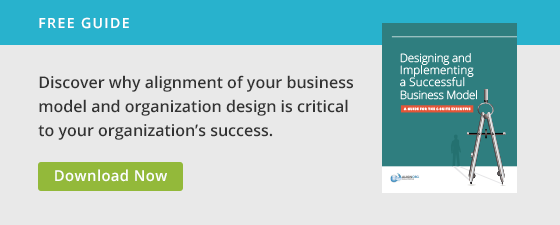In the initial stages of an organization redesign, enthusiasm often runs high. Everyone is excited to brainstorm new ideas and develop new solutions for solving problems or issues in ways that are more effective, efficient, and profitable. But as important as the organization design process is, and as much work as it involves, it’s just the beginning. Once an organization has the new design blueprint in hand, change implementation is the journey ahead.
Getting people to change the way they think, act, and work successfully is a significant challenge. As with any journey, the quality of preparation can make or break the experience. Taking the time to assess and plan your change implementation process will help it go as smoothly as possible.
The Change Implementation Project Team
One of the biggest errors we see organizations make when they are ready to start implementing an organization redesign is to take the “big announcement” approach. A memo is sent out, saying essentially: “We’re making some big changes, and here they are. All these reporting lines have changed, and we expect many good things to happen because we’ve changed these reporting lines and named these new leaders. Now, go forth.” Most people read it and say, “That was interesting. Um, what are we actually supposed to do?”
Often, the changes that are intended have the potential of making positive impacts; however, if the changes are not understood or implemented effectively, results won’t follow.
To avoid this scenario, it’s essential to make sure there is good project management support, good change management support, and a good communications plan and process to take the organization from point A to point B. A strong project/change team responsible for the change implementation process who takes on these various roles and responsibilities will help ensure the intent of your design comes through.
Work Considerations
Once your project team is ready to go, the first thing they need to consider is what about the work needs to change for the organization to be successful. Your organization design blueprint will provide an overview of these changes, but now you need to take it down to a much more granular level with questions such as:
- What work needs to be done?
- Where is the work being done?
- Who is doing it? How will they be trained?
- What kinds of system access do people need to do the work?
Not every aspect of the work may change, but when it does the organization will be faced with more of the same kinds of questions: who should be doing the work, what do we need to communicate with them, what needs to be handed off, how do we make sure the new ways of working are adopted, etc.
People Considerations
Only after achieving clarity on the work to be done should the project team move to the next step in the journey: considering how the changes will affect the people in the organization. Your project team will be asking many people-related questions such as:
- Who do we have today?
- What are they doing?
- What will we need them to do tomorrow?
- Are there changes in their jobs, or will they do the same job in a different way?
- How will these people be trained?
- How will their progress be measured?
- If there are differences in the work they are doing, how will they get the system access they need?
People-related questions can bring up HR considerations and even physical location considerations. There might be job loss. Perhaps you will be outsourcing work. All these things need to be part of the equation when we think about how we will move people from point A to point B.
Incorporating Tools and Technology
The third area the project team needs to address concerns tools and technologies. To bring the greatest value to the organization, it’s critical to take advantage of tools and technologies that can make the work simpler, more streamlined, more effective, and more efficient. Ideally, the project team will create a roadmap to implement tools and technologies that can take this change from just “people and process” to “people, process, and technology”—which usually creates a much more impactful and lasting solution.
Taking the Right Approach to Change Implementation
Organizations that get the right team and the right work plan in place at the outset and then look at these key dimensions—the work to be done, the roles and contributions of people, and the tools and technologies that can be leveraged—tend to have the greatest success in the journey. If you are considering transformational change in your organization, this is something to consider carefully before you send out that “big announcement.”

